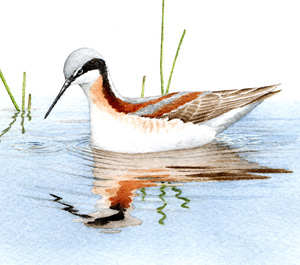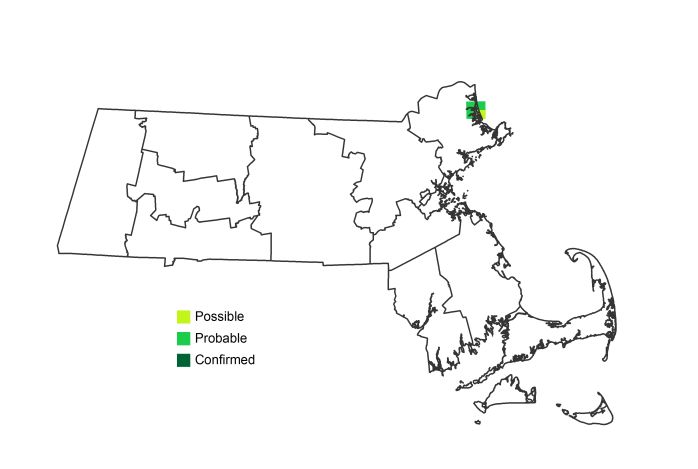Find a Bird
Wilson's Phalarope
Phalaropus tricolor

Very local, trend not established
“The females do most of the wooing. A single male is sometimes chased about by two or more ardent females, but when the nuptials are concluded and the honeymoon is over the henpecked father is said to assume most of the family cares.” – Edward Howe Forbush, Birds of Massachusetts and Other New England States
In fall migration, the Wilson’s Phalarope can occasionally be seen swimming in tight circles at the surface of the water, most often in coastal salt pans. This dizzying display gives the phalarope the appearance of a spinning top, but in actuality it is creating tiny vortices that pull tiny underwater prey to the surface so that the whirling phalarope can grab the prey with its slender bill. Phalaropes are also well known among the sandpiper clan for their aberrant reverse sexual dimorphism and dichromatism; simply put, the females are larger and are more boldly patterned than the males. This reversal of “traditional” breeding lifestyles carries over to their breeding behavior, which until relatively recently could not be appreciated in Massachusetts.
Historic Status
The “Wilson’s Phalarope,” wrote William Peabody in 1839, “is a rare visiter, which, Dr. Brewer tells me, I may insert on the authority of Audubon, who has found it in various places along the eastern coast, from Boston to New Jersey.” And rare it remained for many years with single occurrences noted in 1874, 1889, 1893, and so on. Sightings in the 1920s consisted of single individuals in Ipswich in 1926, and another at City Point in Dorchester in 1928. Since this species was known as a breeder only in the far west for many years, the notion of it ever nesting in Massachusetts was far from the minds of local birders.
Atlas 1 Distribution
With this history in mind, imagine the surprise when the first-ever Confirmed instance of breeding in Massachusetts came in the final year of Atlas 1. A pair of Wilson’s Phalaropes with a trio of eggs was found at Plum Island, where they had constructed their nest in a coastal marsh dominated by cordgrass. As if this was not unusual enough for a species that normally breeds at the margins of shallow freshwater pools, the following year another pair nested at Monomoy. The birds at the Monomoy site also chose a Spartina-dominated salt marsh to call their home.
Atlas 2 Distribution and Change
The Wilson’s Phalarope continues to breed, at least sporadically, in the marshes of the Parker River Wildlife Refuge on Plum Island, although no Confirmations were made during Atlas 2. Despite observations of courtship behavior, pairs appearing to hold territory, and agitated behavior (all acceptable Atlas codes for Probable breeding) at Plum Island during every year of Atlas 2, breeding was not Confirmed.
Atlas 1 Map

Atlas 2 Map

Atlas Change Map

Ecoregion Data
Atlas 1 | Atlas 2 | Change | ||||||
Ecoregion | # Blocks | % Blocks | % of Range | # Blocks | % Blocks | % of Range | Change in # Blocks | Change in % Blocks |
Taconic Mountains | 0 | 0.0 | 0.0 | 0 | 0.0 | 0.0 | 0 | 0.0 |
Marble Valleys/Housatonic Valley | 0 | 0.0 | 0.0 | 0 | 0.0 | 0.0 | 0 | 0.0 |
Berkshire Highlands | 0 | 0.0 | 0.0 | 0 | 0.0 | 0.0 | 0 | 0.0 |
Lower Berkshire Hills | 0 | 0.0 | 0.0 | 0 | 0.0 | 0.0 | 0 | 0.0 |
Vermont Piedmont | 0 | 0.0 | 0.0 | 0 | 0.0 | 0.0 | 0 | 0.0 |
Berkshire Transition | 0 | 0.0 | 0.0 | 0 | 0.0 | 0.0 | 0 | 0.0 |
Connecticut River Valley | 0 | 0.0 | 0.0 | 0 | 0.0 | 0.0 | 0 | 0.0 |
Worcester Plateau | 0 | 0.0 | 0.0 | 0 | 0.0 | 0.0 | 0 | 0.0 |
Lower Worcester Plateau | 0 | 0.0 | 0.0 | 0 | 0.0 | 0.0 | 0 | 0.0 |
S. New England Coastal Plains and Hills | 1 | 0.4 | 100.0 | 4 | 1.4 | 100.0 | 3 | 1.3 |
Boston Basin | 0 | 0.0 | 0.0 | 0 | 0.0 | 0.0 | 0 | 0.0 |
Bristol and Narragansett Lowlands | 0 | 0.0 | 0.0 | 0 | 0.0 | 0.0 | 0 | 0.0 |
Cape Cod and Islands | 0 | 0.0 | 0.0 | 0 | 0.0 | 0.0 | 0 | 0.0 |
Statewide Total | 1 | 0.1 | 100.0 | 4 | 0.4 | 100.0 | 3 | 0.4 |



